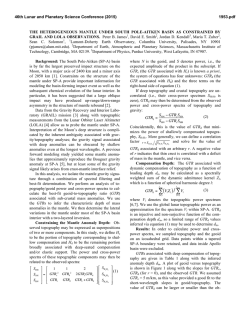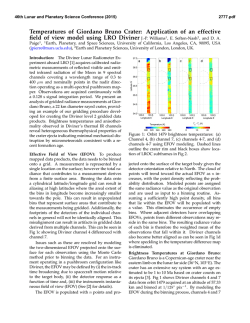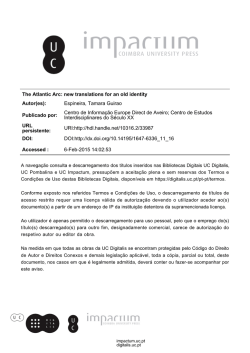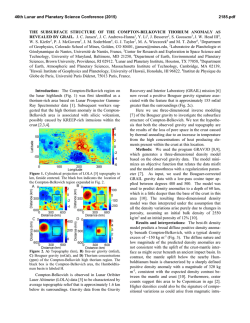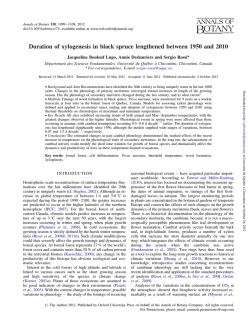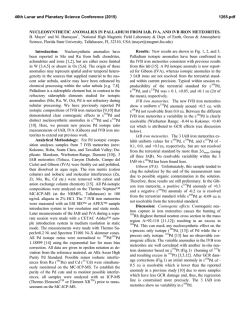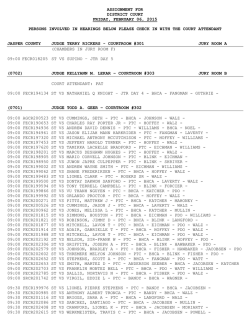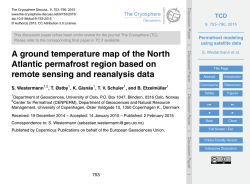
update - Climate4You
Contents: 1 Page 2: Year 2014 and 2013 global surface air temperature overview Page 4: Comments to the Year 2014 global surface air temperature overview Page 5: Sea surface temperature anomaly at the end of the years 2014 and 2013 Page 7: Lower troposphere temperature from satellites, updated to year 2014 Page 8: Global surface air temperature, updated to year 2014 Page 9: Reflections on the significance of the 2014 global annual temperature Page 12: Global satellite temperature trends calculated for different periods Page 12: Global surface air temperature trends calculated for different periods Page 13: PDO - Pacific Decadal Oscillation Page 13: AMO (Atlantic Multidecadal Oscillation) Index Page 14: Annual accumulated cyclone energy (ACE) Atlantic Basin Page 15: Arctic and Antarctic sea ice extension, updated to December 2014 All diagrams in this newsletter as well as links to the original data are available on www.climate4you.com Year 2014 and 2013 global surface air temperature overview 2 Year 2014 (upper panel) and 2013 (lower panel) surface air temperature compared to the average for 1998-2006. Green-yellow-red colours indicate areas with higher temperature than the 1998-2006 average, while blue colours indicate lower than average temperatures. Data source: Goddard Institute for Space Studies (GISS) 3 Year 2014 (upper panel) and 2013 (lower panel) Polar region surface air temperature compared to the average for 1998-2006. Greenyellow-red colours indicate areas with higher temperature than the 1998-2006 average, while blue colours indicate lower than average temperatures. Data source: Goddard Institute for Space Studies (GISS) Comments to the Year 2014 global surface air temperature overview This newsletter contains graphs showing a selection of key meteorological variables for the year 2014. All temperatures are given in degrees Celsius. In the above maps showing the geographical pattern of surface air temperatures, the period 1998-2006 is used as reference period. The reason for comparing with this recent period instead of the official WMO ‘normal’ period 1961-1990, is that the latter period is affected by the relatively cold period 1945-1980. Almost any comparison with such a low average value will therefore appear as high or warm, and it will be difficult to decide if modern surface air temperatures are increasing or decreasing. Comparing with a more recent period overcomes this problem. The average global surface air temperature for 2014. 4 On average, the year 2014 was not very different from 2013. The corresponding sea surface temperature changes 2013-2014 is shown by the diagrams on pages 5-6. The Northern Hemisphere was characterised by regional temperature contrasts. Most of North America had below annual average 1998-2006 temperature conditions, while easternmost Siberia and Alaska had relatively warm conditions. Temperature conditions near Equator were near or below the 1998-2006 temperature average, even though an El Niño situation has been developing during the latter part of 2014 (see p.5). In the Southern Hemisphere surface air temperatures were near or below the 1998-2006 average, especially in the SE Pacific. However, Australia had above average annual temperature. In the Arctic the Canada-Greenland sector had below average temperatures, while especially eastern Siberia-Alaska has above average temperatures. Compared to 2013, the region from eastern Siberia to Alaska was warmer in 2014. Most of the Antarctic continent had below average temperature conditions, with only part of East Antarctica being relatively warm. Compared to 2013, the Antarctic region was cooler than in 2014. Sea surface temperature anomaly at the end of the years 2013 and 2012 5 Sea surface temperature anomaly in late December 2014 and 2013. 6 Arctic sea surface temperature anomaly late December 2014 and 2013. Lower troposphere temperature from satellites, updated to year 2014 7 Mean annually lower troposphere temperature anomaly (thin line) since 1979 according to University of Alabama at Huntsville, USA. The thick line is the simple running 3 year average. The average for 1979-1988 (10 yrs) has been set to zero, to make comparison with other temperature data series easy. Mean annual lower troposphere temperature anomaly (thin line) since 1979 according to according to Remote Sensing Systems (RSS), USA. The thick line is the simple running 3 year average. The average for 1979-1988 (10 yrs) has been set to zero, to make comparison with other temperature data series easy. Global surface air temperature, updated to year 2014 8 Mean annual global surface air temperature (thin line) since 1850 according to according to the Hadley Centre for Climate Prediction and Research and the University of East Anglia's Climatic Research Unit (CRU), UK. The thick line is the simple running 3 year average. The average for 1979-1988 (10 yrs) has been set to zero. Mean annual global surface air temperature since 1880 according to according to the National Climatic Data Center (NCDC), USA. The thick line is the simple running 3 year average. The average for 1979-1988 (10 yrs) has been set to zero, to make comparison with other temperature data series easy. Mean annual global surface air temperature (thin line) since 1880 according to according to the Goddard Institute for Space Studies (GISS), at Columbia University, New York City, USA. The thick line is the simple running 3 year average. The average for 1979-1988 (10 yrs) has been set to zero, to make comparison with other temperature data series easy. 9 Reflections on the significance of the 2014 global annual temperature According to the satellite temperature records (p.7) 2014 was not a record warm year. This is in contrast to the surface air temperature records (p.8-9), which suggest the possibility that 2014 was one of the warmest years since 1880 or 1850. All temperature records are affected by at least three different sources of error, which may differ between the individual station records used for calculation the global average temperature. 1) The accuracy is the degree of closeness of measurements to the actual (true) value. 2) The precision is the degree to which repeated measurements under unchanged conditions show an identical value, true or not. In addition we 3) have the measurement resolution, which is the smallest change in temperature that produces a response in the instrument used for measurement. When combined, this is typically what the expression margin of error attempts to convey for surface air temperature records. The margin of error has been intensively discussed in various new media during the last weeks, and is probably at least ±0.1oC for surface air temperature records, and possibly higher. This makes it statistical impossible to classify 2014 as representing the warmest year in the observational record, as several other years are within the ±0.1oC range of the 2014 value. However, two additional issues relating to the margin of error have not been widely discussed: 1) First, it will not be possible to conclude much about the actual value of the December (and November) 2014 global surface air temperature before MarchApril 2015, when data not yet reported (January 2015) eventually are incorporated in the surface air temperature databases. 2) Secondly, these surface air temperature records display administrative changes over time, which makes it even more difficult to conclude anything about the significance of the recently reported 2014 surface air temperature. The second (administrative) issue is derived from the apparently never ending changes of monthly and annual temperature values carried out by especially the GISS and NCDC databases, with the consequence that what in one particular year was reported as the average global temperature for previous years (and months) are exposed to ongoing administrative changes, that apparently has little or nothing to do with delayed reporting of missing data. This is strongly suggested by the fact that especially the GISS and NCDC databases each month are publishing new changes to monthly temperatures even long before year 1900, where the likelihood of delayed data reporting is very small. Most likely, such administrative changes are the result of alterations in the way the average values are calculated by GISS and NCDC. As an example of such administrative temperature changes is shown below the effect on the GISS mean annual air temperature (MAAT) anomaly record since 2001, with the six different data versions published since January 2010 plotted in one diagram. 10 From this diagram (above) it is obvious that quite substantial administrative changes have been introduced over this short period of just six years. The GISS 2007 MAAT anomaly value, for example, was announced as 0.57 oC in January 2010, 0.58 in January 2011, 0.58 in January 2012, 0.62 in January 2013, 0.63 in January 2014 and 0.62 oC in January 2015. So the GISS 2014 MAAT anomaly value of 0.68 oC published in January 2015 is presumably also going to change for administrative reasons during the coming years, which makes it even more difficult to discuss meaningfully the significance of small temperature differences between individual years. Summing up, 2014 was indeed a warm year in the still short instrumental period (since 1880/1850), but it is not possible statistically to classify it as the warmest year. In addition, there is a noticeable and interesting difference between the global satellite- and surface air temperature records, detailed in the diagram below, as well as in the two diagrams on page 12. 11 Plot showing the average of monthly global surface air temperature estimates (HadCRUT4, GISS and NCDC) and satellite-based temperature estimates (RSS MSU and UAH MSU). The thin lines indicate the monthly value, while the thick lines represent the simple running 37 month average, nearly corresponding to a running 3 yr average. As the base period differs for the different temperature estimates, they have all been normalised by comparing to the average value of their initial 120 months (10 years) from January 1979 to December 1988. Global satellite temperature trends calculated for different periods before December 2014 Diagram showing the latest 5, 10, 20 and 30 yr linear annual global temperature trend, calculated as the slope of the linear regression line through the data points, for two satellite-based temperature estimates (UAH MSU and RSS MSU). Last month included in analysis: December 2014. Global surface air temperature trends calculated for different periods before December 2014 12 Diagram showing the latest 5, 10, 15, 20, 30, 50, 70 and 100 yr linear annual global temperature trend, calculated as the slope of the linear regression line through the data points, for three surface-based temperature estimates (GISS, NCDC and HadCRUT3). Last month included in analysis: December 2014. PDO - Pacific Decadal Oscillation 13 Annual values of the Pacific Decadal Oscillation (PDO) according to the Joint Institute for the Study of the Atmosphere and Ocean (JISAO), a Cooperative Institute between the National Oceanic and Atmospheric Administration and the University of Washington. The PDO is a long-lived El Niño-like pattern of Pacific climate variability, and the data series goes back to January 1900. The thin line indicates annual PDO values, and the thick line is the simple running 7 year average. Last year shown: 2014. AMO (Atlantic Multidecadal Oscillation) Index Annual Atlantic Multidecadal Oscillation (AMO) index values since 1856. The thin line indicates 3 month average values, and the thick line is the simple running 11 year average. Further explanation in text above. Data source: Earth System Research Laboratory at NOAA. Last year shown: 2014. Annual accumulated cyclone energy (ACE) Atlantic Basin 14 Accumulated cyclonic engergy (ACE; Atlantic basin) per year since 1850 AD, according to data from the Atlantic Oceanographic and Meteorological Laboratory, Hurricane research Division. Thin lines show annual ACE values, and the thick line shows the running 7-yr average. Last year shown: 2013. Arctic and Antarctic sea ice extension, updated to December 2014 15 12 month running average sea ice extension in both hemispheres since 1979, the satellite-era. The October 1979 value represents the monthly average of November 1978 - October 1979, the November 1979 value represents the average of December 1978 - November 1979, etc. Last month included in the 12-month calculations: December 2014. Data source: National Snow and Ice Data Center (NSIDC). *************** All above diagrams with supplementary information (including links to data sources and previous issues of this newsletter) are available on www.climate4you.com Yours sincerely, Ole Humlum ([email protected]) January 27, 2015.
© Copyright 2025
